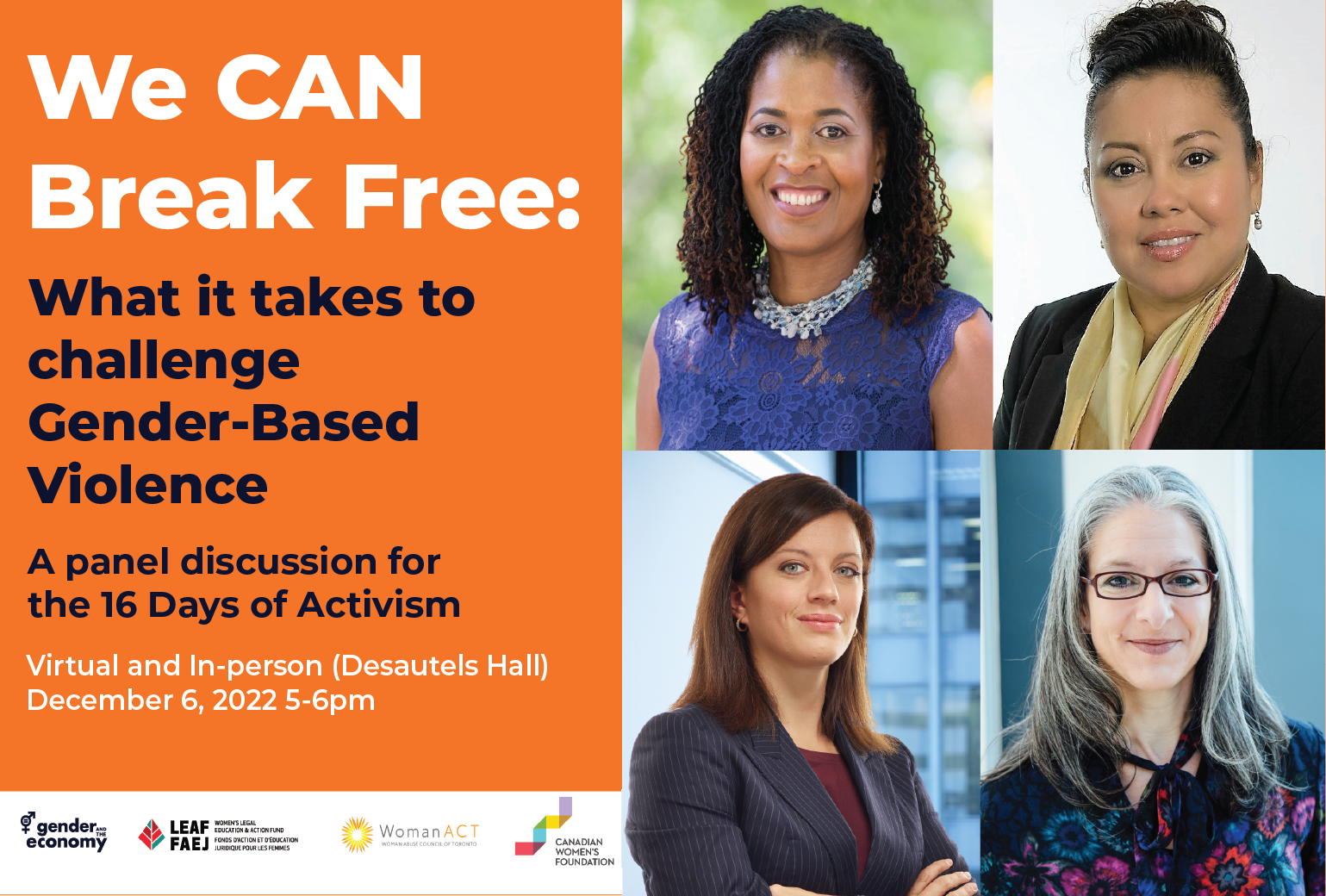Topic: We CAN Break Free: What it Takes to Challenge Gender-Based Violence : A panel discussion for the 16 Days of Activism against Gender-Based Violence
Gender-based violence, a public health crisis, has exacerbated during the pandemic. The Canadian Femicide Observatory’s data shows that 173 women and girls were killed by violence in 2021, a sharp increase from 2019. And according to Women and Gender Equality Canada, at least 44% of heterosexual women, 67% of LGB+ women, and 59% of transgender and gender diverse people have experienced some form of psychological, physical, or sexual violence at home, in public, or at work.
GATE co-hosted a panel discussion with Canadian Women’s Foundation, Women’s Legal and Education Action Fund (LEAF), and Woman Abuse Council of Toronto (WomanACT) on what it takes to challenge bender-based violence. We heard from three experts in the field— Pam Hrick, Executive Director and General Counsel of LEAF, Paulette Senior, President & CEO of the Canadian Women’s Foundation, and Harmy Mendoza, Executive Director of WomanACT— who debunked some of the biggest myths and explored what individuals, organizations, and communities can do to stop gender-based violence and support victims.
GBV in the workplace
Harmy Mendoza highlighted three key suggestions for employers to integrate into the workplace to support survivors of GBV.
- Accountability: Employers should express their commitment to support survivors of intimate partner violence.
- Prevention: Employers should have clear and comprehensive policy procedures in place if a GBV situation arises, and ensure their staff are aware of these policies. Training staff in bystander intervention training is also important in showing commitment to supporting survivors.
- Response: The workplace should have response systems that empower employees by providing informed support services and services that emphasize empathy over judgement.
Consent and the law
Pam Hrick spoke on issues around consent and gender-based violence. She emphasized that a real disconnect exists between what the law says consent is and what is practiced in reality. Although the Canadian legal system has a detailed definition of consent, the justice system does not do a good job of dealing with sexual assault and related crimes. She emphasized that it isn’t built to center the needs of survivors; rather, it often revictimizes them. Pam also spoke of alternatives to the legal system that give further choices to survivors. Systems like restorative justice and transformative justice are grounded in community healing and accountability.
Intersectionality and GBV
Paulette Senior discussed how there isn’t a “one size fits all” approach to combating gender-based violence. She highlighted that policy solutions should take intersectionality into account, otherwise many people who need help slip through cracks in the system. People exist at the intersections of various identities such as race, gender, sexual identity and more. To help survivors, it’s important to understand their lived experiences.
“All kinds of ‘isms” get in the way of serving people well. Being able to work through and view the people you’re working with through the intersectional lens, and understanding the experience through which they come to you for service. But also, them standing at the intersection of various identities which could be race, gender, sexual identity, ability or disability, all of that matters in serving people well.” – Paulette Senior
Watch our panelists share advice on how to challenge gender-based violence
The panelists offered more resources:
Learn more about the Signal for help from the Canadian Women’s Foundation and sign up to be a Signal Responder.
Read the new report by Woman Abuse Council of Toronto (Woman ACT) on intersections between employment and safety among racialized women
Learn more about sexual assault and consent law from the Women’s Legal Education and Action Fund (LEAF)




